If you were wondering whether today would be the day you would finally get to see a shirtless Marshal Tito and his dog take some time off for a dip during a stay at one of his many villas, wonder no more.


If you were wondering whether today would be the day you would finally get to see a shirtless Marshal Tito and his dog take some time off for a dip during a stay at one of his many villas, wonder no more.

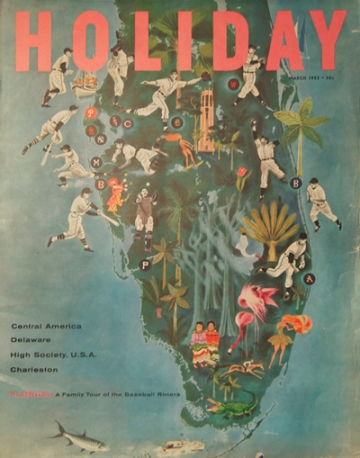
Nobody can know Brooklyn, because Brooklyn is the world, and besides it is filled with cemeteries, and who can say he knows those people? But even aside from the cemeteries it is impossible to say that one knows Brooklyn. Three blocks from my present house live two hundred Mohawk Indians. A few blocks from them are a group of Arabs living in tenements in one of which is published an Arabic newspaper. When I lived on Schermerhorn Street I used to sit and watch the Moslems holding services in a tenement back yard outside my window, and they had a real Moorish garden, symmetrically planted with curving lines of white stones laid out in the earth, and they would sit in white robes—twenty or thirty of them, eating at a long table, and served by their women who wore the flowing purple and rose togas of the East. All these people, plus the Germans, Swedes, Jews, Italians, Lebanese, Irish, Hungarians and more, created the legend of Brooklyn’s patriotism, and it has often seemed to me that their having been thrown together in such abrupt proximity is what gave the place such a Balkanized need to proclaim its never-achieved oneness.

Michael Herr, a free-lance writer and a resident of Greenwich Village, makes his first appearance in Holiday with this article.
One noontime last spring a photographer, two assistants, a lady editor and a fashion model turned up at the corner of Bleecker and Leroy Streets, in Greenwich Village. This is a tenement block and a market district, the nucleus of what is left of the old Bleecker Street community. At this time of day, when Our Lady of Pompei School lets out for lunch, the streets are packed with tough, bright, well-behaved kids whose tumult fills Leroy Street, spilling onto Bleecker. They wear blue blazers with gold-stitched crests on the pockets. The model was dressed in leather, something from one of the fall collections with a wicked, constricting cut to it. Continue reading

1958 Holiday subscription offer
Now that the holiday shopping season has begun, why not subscribe to Holiday? Only $14 for a four-year gift subscription!

I have included links where I thought they would be helpful; obviously a magazine from 1965 did not contain hyperlinks. —Josh
*
With the Christmas season and Christmas giving in mind, the Editors asked some of America’s distinguished authors and critics to contribute to an unusual list of books—books that are excellent but for some reason failed to attract wide attention. Here are the responses, each a rich tribute to a favorite neglected piece of good reading. Continue reading
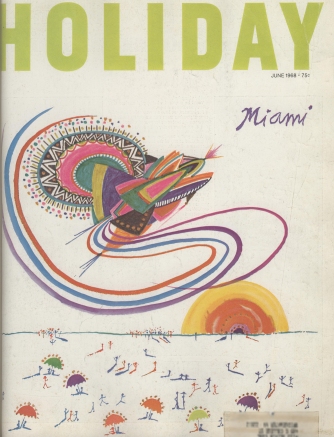
This article comes courtesy of Lary Wallace, a big Michael Herr fan who transcribed the article for his site Pluto’s Orbit. Thanks, Lary.
…
A hundred miles from Bogota, south of Villavicencio, the plains of Colombia end and the jungles begin, running in unbroken density for more than 600 miles to the Amazon River. Colombia’s eastern border forks, like a snake’s tongue, and meets the river at two points. Leticia, on the southeastern tip, is the fourth largest town along the river, after Belem and Manaus in Brazil, and Iquitos, two hundred miles upriver, in Peru. A few steps out of Leticia will put you near the Brazilian army garrison just over the border, and a few hundred yards across the river, beyond the Colombian gunboat somewhere anchored in the harbor, you can see a Peruvian island. Leticia is the capital of Amazonas, a Colombian territory so remote that it has been called the world’s last true frontier. Continue reading
If you’re into Holiday magazine (if you’re reading this, you probably are) and you have some money to burn (I have no idea about your finances), check out this huge lot of 237 issues of Holiday on eBay. It’s certainly the biggest Holiday offering I’ve ever seen.
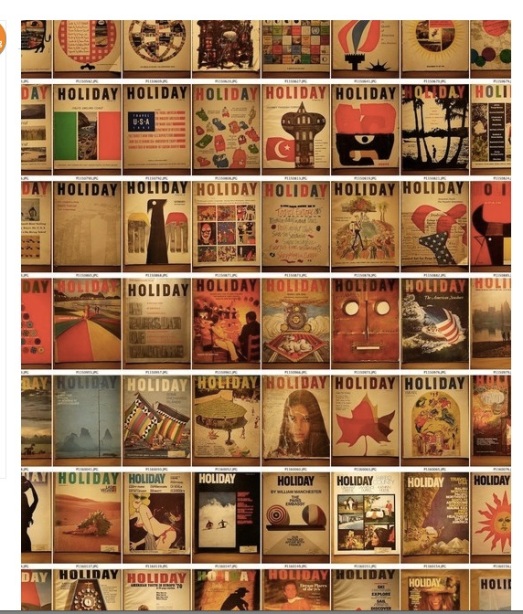
Sorry for the lack of updates. Scanning those large-format pages and converting the text is a time consuming process.
In the meantime, the May 2013 Vanity Fair has a piece about Holiday by Michael Callahan. (As of this writing, the article is not available online.) It is now online, along with a nice gallery of Holiday covers.
To further tide you over until new articles appear in this space, here is a photo of my coffee table. Not sure why that would help, but there you have it.
And if you’re still looking for something to read, there’s always my other site, Carry On.
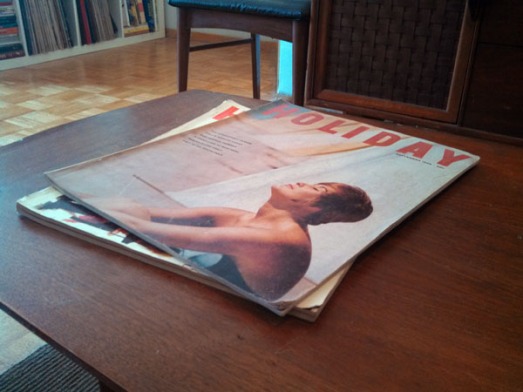
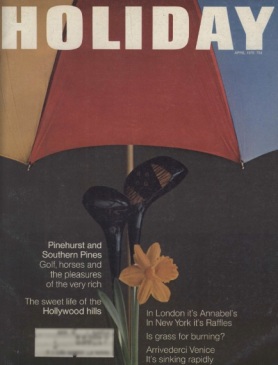
Or, “How old should a child be before his parents tell him he lives in the valley?”
The cliffdwellers cling precariously to the brush-covered slopes of the Hollywood hills, sharing the common perils of fire and flood. In the late fall, when the humidity drops and a warm wind whips through the canyons, the hills may suddenly explode with flame. In the rainy season, when the naked cliffs crack and slide, the mortgaged wickiups come tumbling down. But the true cliffdweller always returns to his wildlife refuge. He trades in his charred Porsche, patches his pool, rebuilds his house-with-a-view and again settles down to enjoy the comforts of his mountain lair.
He has the best of two urban worlds. He is minutes away from the city’s offices, shops and restaurants, but when his day’s work is done, he comes home to down his tot of gin in a green and private place where ruby-throated hummingbirds flutter in the bottle-brush and quail skitter across his lawn. Mule deer drink from his pool and foxes feed from his garbage pail. His children are turned loose to climb trees, collect snakes and chase rabbits.

JERUSALEM’S UNIQUE ZOO IS A LIVING BIBLICAL BESTIARY
The Biblical Zoo in Jerusalem, a concept inspired by the Prophets, is the only one of its kind in the world—a source of amazement not only to laymen like myself but, in even greater degree, to visiting zoologists and theologians. Here on thirty-two acres of the Holy Land’s rugged brown soil, the beasts and the birds mentioned in the Old Testament have been brought together. On their cages appear the Biblical quotations applicable to each creature. As you glance down from the contemptuous eyes of two splendid ostriches, both towering ten feet high, you read in Hebrew and English: “I am a brother to monsters and a companion to ostriches.” (Job 30:29) And where three of the most beautiful lions ever raised in captivity roar for their food, a placard quotes: “The lion hath roared—who will not fear?”(Amos 3:8)
The first glimpse of the Biblical Zoo may be something of a shock. This is not an exquisitely landscaped zoological garden such as you find in other cities. As you enter its creaking gate, crude paths lie ahead. All about them are massive boulders pockmarked by erosion. And among the rocks are growths of untended underbrush, clumps of twisted trees.
Yet this very crudeness is deliberately preserved because it establishes a proper mood for the zoo. Surely this is the way the Holy Land must have looked when some of these animals roamed its ancient hills, when some of these brilliantly plumed birds flew screaming from tree to tree. As you pass, they still scream at you—parrots and peacocks, magpies and ravens, just as they screamed at men in the years of Abraham, Isaac and Jacob. Today, they screech at more than 120,000 visitors a year.